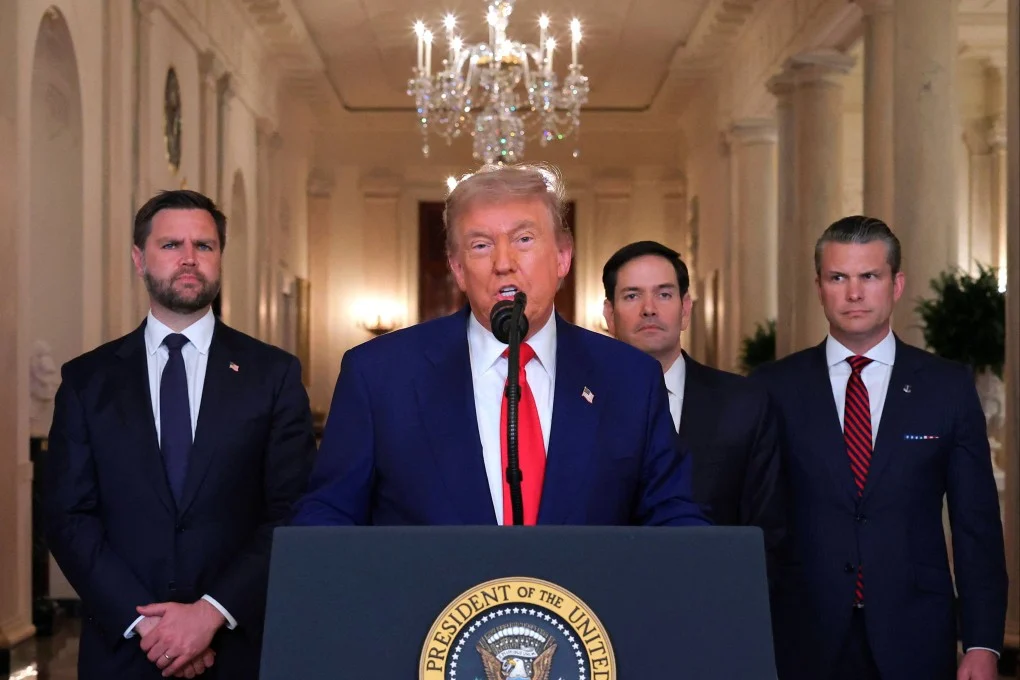President Donald Trump, speaking from the White House late Saturday night, confirmed what many had speculated for days: the United States has carried out coordinated airstrikes on three of Iran’s nuclear enrichment facilities—Fordow, Natanz, and Esfahan. In a brief yet pointed national address, the president declared the operation a “spectacular military success,” signaling a seismic shift in America’s role in the escalating Israel-Iran conflict.
The U.S. bombed the "crown jewel" of Iran's nuclear program, FOX News' @JenGriffinFNC reports. pic.twitter.com/4gfflMuAMC
— Fox News (@FoxNews) June 22, 2025
After weeks of diplomatic brinkmanship and mounting regional tension, Trump took to Truth Social to break the news: the U.S. had launched strikes that directly targeted Iran’s core nuclear infrastructure. “We have completed our very successful attack,” the president posted, noting that Fordow—considered Iran’s most fortified underground site—was hit with a “full payload of BOMBS.”
Shortly after, Trump appeared on national television flanked by Vice President JD Vance, Defense Secretary Pete Hegseth, and Secretary of State Marco Rubio. His message was resolute:
“Iran’s key nuclear enrichment facilities have been completely and totally obliterated”
The statement echoed the administration’s growing concern that diplomacy alone would not deter Tehran’s ambitions.
While the scale of destruction remains under analysis, early reports indicate the strikes represent the most aggressive U.S. military action against Iran in modern memory. The decision to strike was not taken lightly. Trump had publicly floated a two-week decision window to allow for final diplomatic attempts—a window that closed once negotiations with Tehran stagnated and Iran rebuffed calls for unconditional disarmament.
President Donald J. Trump Delivers Address to the Nation, June 21, 2025 https://t.co/yutRDvtWv0
— The White House (@WhiteHouse) June 22, 2025
The mission’s strategic execution involved elite B-2 stealth bombers and precision-guided munitions. These aircraft are among the only platforms capable of delivering the 30,000-pound bombs necessary to breach Fordow’s deep mountain protection.
At the Pentagon, military officials stressed the need to act swiftly to avoid long-term entanglements. U.S. forces in the region had already been bolstered with squadrons of F-16, F-22, and F-35 fighters, destroyers along the Israeli coast, and the arrival of the USS Carl Vinson in the Arabian Sea. A third carrier group, the USS Ford, is expected to join in the coming days.
Despite the magnitude of the operation, Trump was quick to stress that America remains open to peace.
“We’ve gone a long way to erasing this horrible threat to Israel,” he said, before adding, “But if peace does not come quickly, more strikes will follow”
The strikes mark a defining moment in Trump’s second term—one that underscores the recalibrated interpretation of his “America First” doctrine. No longer viewed as isolationist, the strategy now includes preemptive action when diplomatic avenues fail and allies are under existential threat.
Predictably, reactions have been polarized. Some libertarian-leaning voices argue that American involvement risks escalation. However, the broader conservative base appears largely united in support of the president’s decision, viewing the operation as a necessary stand against Tehran’s nuclear defiance.
Strategists suggest the move may have been inevitable. With European-led negotiations faltering and Iran doubling down on inflammatory rhetoric, the path forward narrowed. Trump’s supporters see this moment as decisive leadership under pressure—a move that avoided prolonged conflict by opting for swift, targeted action.
As the world watches for Iran’s next move, President Trump has made one thing clear: the U.S. won’t sit on the sidelines when peace, stability, and allied safety are on the line. With America’s military strength now unmistakably on display, Trump has once again taken the lead—willing to carry the burden of hard decisions, with the resolve to act when the moment demands it.
ABC News contributor and retired Col. Steve Ganyard explains how the 30,000-pound "bunker buster" bomb works; the bomb can only be carried by B-2 bombers. https://t.co/JWgWIXSFMa pic.twitter.com/Ml1HdsM6wM
— ABC News (@ABC) June 22, 2025


